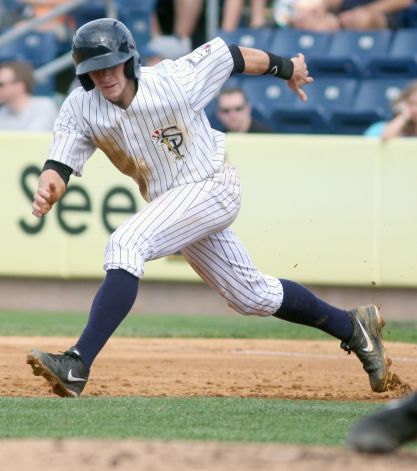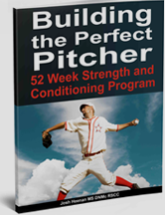The 60-Yard Dash: A Case Study
The 60-yard dash is often one of the first quantitative tests scouts at both the college and professional levels wish to see performed well.
This test has been deeply engrained into the dogma of baseball, while science and many coaches believe that there are better options. The 60-yard dash tests acceleration, top speed, and maintenance of top speed over 180 total feet. In general, baseball is a sport of acceleration and deceleration, not top speed. Regardless of it’s applicability many coaches and scouts use it as a gauge of athleticism and should at least be a consideration for athletes wanting to been seen as competitive. Here’s a case study to show how we address improving speed.
As an incoming freshman shortstop at Sacred Heart University, John Murphy had a 7-7.1 60-yard dash. With a front squat max of 245 and a vertical jump of 25 inches his power and strength was considered average to below average for SHU’s program.
My favorite test for both power and asymmetries is the single leg triple jump (SLTJ). The test is performed by standing on one leg and making 3 consecutive broad jumps on the same side while remaining in control. The goal is to jump as far away from the starting point while sticking each landing. When there is a side-to-side discrepancy of over a foot I investigate deeper to see if we are dealing with strength deficit or something more structurally.
Scoring an average of 21 feet on each side puts John right in the middle of a team average of 22, nothing special to say the least. The ability to apply force into the ground and accelerate your body forward gives us a nice picture of single leg power and a large carryover to running.
As you can see in the chart, as the years progressed, John’s squat, single leg triple jump, vertical jump, and front squat to bodyweight ratio make improvements every year. Increasing relative strength compared to bodyweight and teaching how to increase force production once movement dysfunctions are addressed will consistently increase speed— more importantly acceleration.
An interesting fact to note when looking at the data is that John’s junior year is when he really took his diet to the next level. When dealing with athletes of all levels it clicks at different times. Sometimes this has to do with whom they spend the majority of their time with and sometimes it just takes time to see the light at the end of the tunnel with a goal. Either way, John honed in on his diet by adding about 10 lbs of muscle and dropping a few of fat, again increasing his potential to produce force and become faster.
By John’s senior campaign he had been clocked as low as 6.5 in his 60 and was easily the most powerful athlete in his program. Looking back at his freshman year 21 foot triple jump (7 feet per jump) and increasing it to 26 feet (~8 ½ feet per jump) is a very large difference. This effectively lengthens his stride without changing his mechanics and drops 3-5 strides or ground contacts during his 60-yard dash, dramatically decreasing his time to plus speed in the eyes of MLB organizations.
When training athletes, strength coaches often forget the goal of athletic performance. Our job in the weight room is to help minimize or prevent injury, increase movement efficiency, increase overall strength, and increase force production in a way that it relates to our athlete’s events. You can see we did not test vertical jumps in 2012 because after the past 6 years I have come to realize that the carry over to baseball or other athletic development is much larger with the triple jump gave me lots of qualitative and quantitative data to use in our programming compared to vertical jump data.
Tips to Increase Acceleration Speed
-Video tape and practice your 10-yard dash. Use the video to get your current time and work to improve it. Once your 10-yard dash goes down, your 60 will drop dramatically.
-Increase your front squat max to 1.7-2x bodyweight with solid depth.
-Minimize fat mass and optimize muscle mass. Murph has had his bodyfat as low as 4.5%. By carrying minimal fat mass all weight is functionally producing force.













Haden 6:58 pm on September 18, 2013
Hi josh I’am 15 years old and I was wondering what I can do to get faster. I am very slow and I run a 8 in the 60 yard dash
Josh Heenan 7:21 pm on September 18, 2013
Haden,
Post a video of your 60 yard dash from the side and I will check it out.
Haden 12:08 am on September 19, 2013
Ok and do you think I could bring that time down to a 6.7 in three years
Josh Heenan 9:23 am on September 19, 2013
Haden,
At minimum, you would need to drastically change your body composition and increase your movement efficiency, base strength, and power. Post your 10 and 60 yard dashes in the comments and I’ll check them out.
Kelvin 7:53 pm on September 18, 2013
I amm18 years old and run a 6.9 60-yard dash. How can I increase my speed?
Josh Heenan 9:21 am on September 19, 2013
Kelvin, Post a video of your 10 and 60 yard dashes from a side view and I will check them out.
Brendon 12:39 pm on September 20, 2013
Hey would the single leg triple jump help with pitching in any way with using the legs to push for power? Im 16 and throw around 83 mph. Is there any good way to improve my speed pitching
Josh Heenan 1:14 pm on September 20, 2013
Brandon,
Pitching is a max effort movement with many requirements including great deceleration from the lead leg and max power from the trail leg. The triple jump has nice carry over to throwing speeds in my experience. Pitching is more about force production with quality mechanics. Bring up your triple jump and your 60 time will drop as well as MPH will likely increase.
5 Tips to Improve Your 60-Yard Dash | JoshHeenan.com 8:31 pm on September 26, 2013
[…] ← The 60-Yard Dash: A Case Study […]
T 10:18 pm on January 8, 2014
Hi, I run a 7.4 sixty and am about 160, 5’11”. What should I do to increase weight and speed? I’m only a freshman, and it might be important to note I am a catcher.
Dr. Josh Heenan | 5 Tips to Improve Your 60-Yard Dash 9:20 pm on September 25, 2014
[…] discussed in the 60-Yard Dash: A Case Study post, the 60 is not the most applicable test of “speed” for baseball players, but it is one […]
Dr. Josh Heenan | Add Muscle Mass, Get Recruited and Drafted 12:01 am on June 10, 2015
[…] and increased bodyweight increases potential force output, which is one of the keys when trying to run faster and throw harder. Not only is added muscle mass important for injury prevention, but it terms of […]
Add Muscle Mass, Get Recruited and Drafted | Josh Heenan 5:07 am on August 4, 2015
[…] and increased bodyweight increases potential force output, which is one of the keys when trying to run faster and throw harder. Not only is added muscle mass important for injury prevention, but it terms of […]